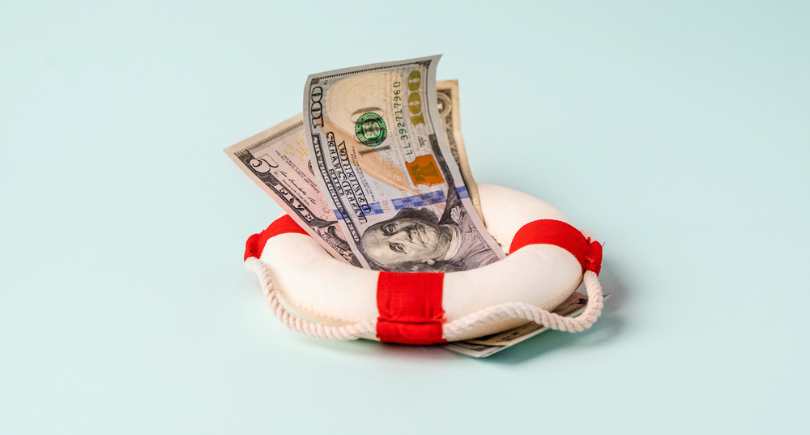
It’s a common question: Should you focus first on paying off debt or building an emergency fund? Unfortunately, there’s no black-and-white answer. Rather, paying off debt versus building an emergency fund is more of a gray area. Ultimately, which option you choose depends on your unique circumstances.
“Financial wellness is a journey, not a destination, and strategies should consider personal needs, current financial situation and life stage, while ensuring flexibility to adapt and build based on changing needs,” said Suzanne Schmitt, head of financial wellness at New York Life, a provider of insurance, investment and retirement products. “While building emergency savings and paying down credit card debt are both components of a financial wellness strategy, the prioritization is personal, depending on the journey.”
Some financial experts believe you should concentrate on paying off credit card debt before putting money into an emergency fund. Others favor the opposite approach — establishing an emergency fund before wiping out credit card debt. Still other experts insist you should do both at the same time.
Let’s take a look at each of these three options.
1. Paying off credit card debt first
On her website, personal finance expert Suze Orman says it “makes plenty of sense” to pay off credit card debt before building an emergency fund. Why? Because credit cards tend to charge more interest than you’ll earn on savings. Therefore, she says, it’s “a smart financial move” to allocate lower-interest savings toward higher-interest debt.
Orman’s website notes that if you have credit card debt, “you need to make it your top priority to get it paid off ASAP.”
As of April 2023, the average interest rate for a savings account stood at 0.39%, according to the Federal Deposit Insurance Corp. (FDIC), although some high-yield savings accounts were offering interest rates above 5%. Meanwhile, the average interest rate charged in March 2023 by credit card issuers exceeded 20%, says the Federal Reserve.
It doesn’t take a math wizard to see that the average interest rate for a credit card clobbers the average interest rate for a savings account. In the end, high-interest credit card debt could be eating up more money than you’re gaining from a savings account.
Bottom line: Given that the average credit card balance in 2022 was $5,910, up 13% from the previous year, it might be better to initially erase higher-interest debt than to stash money in a lower-interest savings account.
➤ LEARN MORE:Inflation hurting your debt deletion plans? What can help
2. Building an emergency fund first
Orman and other experts also make the case for prioritizing an emergency fund over debt reduction. This is particularly true if you’re carrying low-interest debt.
In March 2023, Orman cited recent bank failures coupled with the threat of a recession as reasons to supercharge your emergency savings. Amid that climate, an emergency fund is “absolutely vital,” she told CNBC.com.
Bruce McClary, senior vice president of memberships and communications at the National Foundation for Credit Counseling, echoes the importance of setting up an emergency fund. He said building an emergency fund can keep you from racking up high-interest debt — in the form of credit cards or payday loans, for instance — when surprise expenses pop up, such as car repairs or medical bills.
“Once you have built up enough savings, you can then focus on paying off your credit card debt faster,” McClary advised.
Generally, experts suggest creating an emergency fund with enough money to cover three to six months’ of everyday expenses. Orman recommends an eight- to 12-month target.
Sadly, many Americans don’t even have enough emergency savings to cover even one month’s worth of household expenses.
A survey commissioned by SecureSave, a company co-founded by Orman that helps employees establish emergency savings through their employers, indicated that 67% of Americans aren’t able to cover a $400 emergency expense.
Not all the news about emergency savings is bad, though.
In a New York Life survey, American adults listed establishing an emergency fund as their top financial goal for 2023 (34%), followed by paying off credit card debt (28%) and building up retirement savings (28%). Among adults with an emergency fund, nearly half (47%) reported an average balance of $16,776.
Bottom line: To avoid accumulating high-interest debt when a surprise expense arises, it might be wise to aim to fuel an emergency fund rather than to pay off credit card debt.
3. Paying off credit card debt and building an emergency fund
In some cases, paying off credit card debt while building an emergency fund might be the best way to go — especially if you’re dealing with only a little credit card debt and just a little bit of emergency savings.
Schmitt says that both debt reduction and emergency savings should be part of a broader financial strategy. “Focusing only on one approach at a time could have negative effects on your long-term financial health.”
For instance, contributing to your emergency savings without paying the minimum amount on your credit cards only leads to more fees on top of high interest rates, which could dig you into a deeper credit card debt hole that is harder to get out of. On the other hand, if you only pay down your credit card debt and do not contribute to emergency savings, you could be left unprepared for a life event, such as a health emergency, disabling event or loss of income.
McClary said that even if you’re saddled with high-interest debt, you can craft a manageable plan to pay more than the monthly minimum balance on your credit cards while also amassing emergency savings. Once you’ve reached your savings goal, he added, you can earmark even more of your money for chipping away at credit card debt.
Bottom line: Reducing your credit card debt while also adding to your emergency savings may help set you up for a brighter financial life. But you’ll want to carefully weigh that strategy if you’re coping with a mound of high-interest credit card debt.
Using credit cards for emergency expenses
Putting emergency expenses on a credit card isn’t necessarily a bad thing, particularly if you have little to no emergency savings. For instance, a credit card might be your only option for paying a surprise medical bill.
If you find yourself in a situation like this, consider applying for a card that offers 0% intro APR on purchases or balance transfers. These offers can save you hundreds or perhaps thousands of dollars in interest — as long as the regular APR doesn’t kick in before you pay off the balance covered by the introductory 0% APR period. Otherwise, you’ll be hit with hefty interest charges.
If you can’t qualify for a credit card with a special 0% APR offer, it’s best to turn to plastic only as a last resort for paying emergency expenses. In other words, don’t use your credit cards as an emergency fund. Instead, focus on starting or bulking up an emergency fund, even if you’re able to come up with just $1,000 as a cash cushion. “Something is better than nothing,” as they say.


